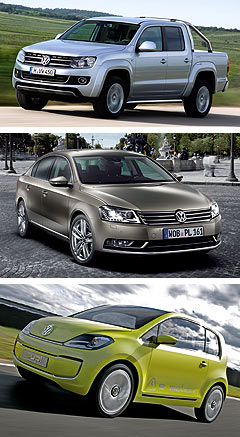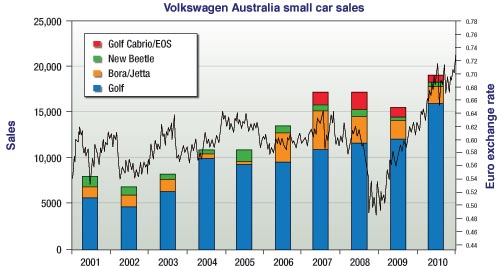Make / Model Search
News - VolkswagenVW goes up by going downPeople's car: The most affordable Golf ever comes courtesy of the strong Aussie dollar. New models at cheaper prices help Volkswagen reach deep into small-car territory4 Oct 2010 VOLKSWAGEN is taking on the Asian car-makers in Australia with a new $22,000 price-point for Golf as it pursues its quest to double sales in this country by 2018. Even with Golf sales already growing at twice the rate of the top-selling small-car segment, the number one European brand obviously reckons there is plenty of upside left in its small cars for Aussie buyers. That’s not really surprising if you look at the accompanying graph, which traces the strength of the Australian dollar against the Euro, overlaid on a 10-year graph of Australian sales for Golf and VW’s other small and light passenger cars such as Polo, Jetta, Beetle and EOS. With the Euro exchange rate currently sitting at about €0.70 to the AUD, Australian importers are getting about 16 per cent more bang for their buck than when it was consistently around €0.60. For importers, cheaper landed cost also means a lower import duty bill and a reduced GST slug. Car importers are ever-cautious about betting that such currency trends will last. In fact, they often bet they won’t, by hedging currency against potential sudden movements – such as the plunge of the Aussie dollar against the Euro at the height of the global financial crisis in 2008, and its equally sudden reversal once the parlous state of countries such as Greece and Portugal became apparent.  From top: Volkswagen Amarok, Volkswagen MY2011 Passat, Volkswagen e-Up! From top: Volkswagen Amarok, Volkswagen MY2011 Passat, Volkswagen e-Up!Importers also are reluctant to drop vehicle prices with every currency gain, as it then becomes painful to raise them again when the currency moves the other way, upsetting potential customers and dealers alike. Better to keep prices steady. Clearly, though, VW is on a roll. With every new model it slips onto the Australian market, it is trying to ramp up value to pull its range down from its pseudo-prestige pedestal – where it was forced to live for so many years by the exchange rates – to everyday fare (in price, at least), which is its natural habitat in Europe. This is extremely bad news for the Japanese importers, who now find themselves being squeezed from the top as well as the bottom, where not only the Koreans are advancing in large strides but Chinese manufacturers such as Chery and Geely are about to arrive in force. But this is Australia – the number one proving ground for car-makers in the world. If you make it here, where east meets west, then other markets beckon. Toyota, Hyundai and Mazda, for example, all used this country to hone their models and selling techniques in a relatively small but competitive and mature battleground before establishing themselves on the world stage, and it is the same with the coming Chinese invasion. If VW really wants to achieve its publicly stated aim to be world number one by 2020, there is no better place to start than right here. To do that, it not only has to get into the popular ute market (Amarok is on its way), SUV segment (the Golf-based Tiguan is here and a new Touareg beckons) and medium class (a new Passat has just been launched in Europe), but must also take on the Asian importers – as well as Holden with its new locally made Cruze from next year – head-on in the small and light car classes. As we can see from the graph, VW has depended heavily on the Golf hatchback to make small-car headway over the past decade, with derivatives such as the New Beetle, Jetta sedan, EOS coupe-cabrio and the unkindly named Bora waxing and waning. Part of that can be attributed to fashion – specialty cars such as the Beetle and EOS enjoy a rush of buyers when fresh, but their staying power is questionable. Their slide contributed to a small decline in VW small and light car sales in 2008 and 2009, despite Golf’s increased contribution. But help is at hand, with the arrival of the new 1.2-litre TSI entry-level Golf hatchback variant this month, along with a spruced-up version of the GTI in league with Adidas and a fuel-sipping BlueMotion diesel Golf coming for 2011. Then there is the VW small-car headline act for 2011, the Mexican-made ‘Golf with a boot’, the new-generation Jetta sedan. As well, Polo gets its flagship, the Polo GTI, next year. But the biggest move by VW into the affordable end of the market is expected to hit the streets of Europe – and most likely Australia – in the form of the Up city-car in 2012. This sub-Polo four-seater may well be the biggest thing in small cars, with VW aiming to hit the reset button on automotive engineering in the same way it did with Golf and, before that, the original Beetle. For several years now, VW has been working on the new Up concept, which will spawn a whole family of cars – VW calls it New Small Family – with a multitude of powertrain choices: petrol, diesel, hybrid and full electric. As well, a range of bodies are being developed. With it, VW plans to have all bases covered for whichever way the market moves in an increasingly urbanised world, especially when the next oil price shock arrives. VW has confirmed that the Up will go into right-hand drive production and is under consideration for Australia, thanks to the new exchange rate paradigm. It might be a ‘premium’ city runabout, but it will also have a VW badge.  Read more |
Click to shareVolkswagen articlesResearch Volkswagen Motor industry news |










Facebook Twitter Instagram